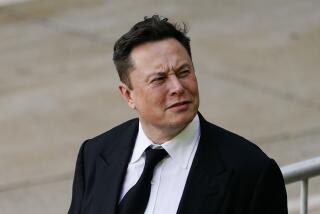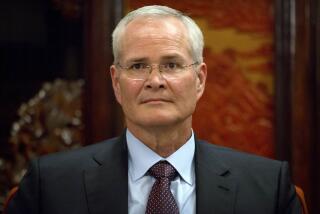War of Words Rages Over Lockheed : Corporate campaign: The company is spending $8 million in the fight to maintain control of its board and generate public support. Challenger Harold Simmons has committed about $6 million.
- Share via
As the proxy fight for control of Lockheed Corp.’s board nears an end, each side is spending millions of dollars to bombard not only shareholders, but also the public in general, with attacks on the opponent and promises of a more profitable future.
Lockheed says it is spending $8 million on the campaign, and the challenger, Texas financier Harold C. Simmons, has committed about $6 million through the Simmons-controlled company, NL Industries, that is his vehicle for the challenge.
Lockheed’s annual meeting will be held Thursday, but results of the proxy fight are not expected to be announced until sometime after the meeting.
Much of both sides’ campaign money is being spent on newspaper advertising, and the number and type of the ads make clear to corporate campaign professionals that the combatants are trying to appeal to more than just the company’s shareholders--even though only shareholders can vote.
The experts say that the use of costly full-page newspaper ads has been unusually heavy, and that means the two slates are reaching for the hearts and minds of the larger public.
Peter Morrissey, president of Clarke & Co., a Boston firm that develops “crisis communications” for companies that need to reach the public with a message, said the Calabasas-based aerospace company and Simmons appear to be trying to sway shareholders by generating public support.
“There’s no evidence that this is effective,” he said, adding that “winning the hearts and minds of the people takes time.” On the other hand, he said, “There’s no evidence that it isn’t effective.”
NL Industries, a Houston chemical firm that has an 18.9% stake in Lockheed, must spend heavily if it hopes to win control of Lockheed because corporate challengers rarely defeat incumbent directors.
But Herbert E. Knoll, president of the Total Executive, a Buffalo, N.Y., firm that runs public relations and marketing campaigns for companies and individuals, said it is unprecedented for a dissident faction to bring such a large campaign purse to a corporate proxy fight.
Simmons “has to take his case to the people,” Knoll said. “If he does it well . . . shareholders and other people will be talking about this (fight) over lunch.”
The two sides are not relying solely on newspaper advertising. They are also mailing statements to shareholders and meeting with pension fund managers and other institutional investors who hold significant amounts of Lockheed stock.
They are also trying to woo members of the Lockheed Employee Stock Ownership Plan, who own nearly 19% of the aerospace firm’s stock. Both sides have distributed leaflets and campaign buttons near Lockheed facilities.
But newspaper advertising appears to be a major weapon in the fight.
NL Industries has bought advertisements carrying 12 different messages in about a dozen newspapers in various parts of the country; the first ad was placed Feb. 28. The ads have appeared in major newspapers, like The Times, the Wall Street Journal and the New York Times, but they have also been placed in smaller papers published in New Hampshire, Texas and Georgia, where Lockheed operations are situated.
Lockheed’s directors have responded to the challenge with their own ads. The first one ran March 5, and Lockheed management has since placed seven more in the same newspapers that have published NL Industries’ ads. Each of the eight has had a different message.
Thus far, it’s been tit for tat. NL Industries’ ads have contained criticism of Lockheed’s diversification efforts, contending that the company should focus more on its core aerospace and defense contracting business. Lockheed has defended its policies, saying that it must reduce reliance on military-related business in the face of declines in Pentagon spending.
Each side has suggested that its adversary has been less than straightforward. The Simmons camp took its shot in an ad that appeared March 20. It had two columns. One contained quotes from the Lockheed annual report; the other contained a “translation” designed to counter the Lockheed statement.
“We characterize 1989 as a transitional year which prepared us for strong financial performance in 1990 and beyond,” said one excerpt from the Lockheed report.
The NL “translation”: “1989 was a bad year.”
Lockheed has also produced its own interpretive messages. In ads published Monday, Lockheed juxtaposed a list of Simmons’ statements in one column with a list of what it says his actions were in the other.
“NL’s nominees say: They are against ‘greenmail,’ ” said the Lockheed message. “But . . . Harold Simmons has accepted greenmail in the past.”
Both factions have also raised the issue of board qualifications. Lockheed, addressing the issue in a March 14 ad, presented its case relatively early in the campaign.
“To our knowledge, neither Simmons nor any of the NL director nominees has any experience as an executive officer with a major company in the defense industry,” the message said. “Who is better suited . . . Simmons and his associates or your current board (?)”
Meanwhile, NL Industries has been touting its slate with photographs and biographies, saying in one ad, “The NL slate includes, in our view, leading experts in space and defense systems and procurement, successful entrepreneurs, nationally recognized economic and investment analysts, and individuals with years of experience leading and advising large publicly held corporations.”
Also, each faction has suggested that its slate has a well-conceived management formula that could usher in better days for Lockheed.
An NL ad said: “(We) believe the Simmons team can successfully apply this value-enhancing approach to Lockheed.”
A Lockheed ad said: “(We) have been implementing a program which we believe will position Lockheed for growth in profitability and shareholder value.”
Both sides have bristled at the content of the other side’s messages. Simmons says Lockheed makes “unfair” use of his business history as it cited a 1985 court ruling against him for improper use of a company pension fund he controlled.
“I’ve been characterized as a raider--and that has so many negative connotations,” he said in an interview. “I consider myself an investor who takes a position in a company and makes it successful.”
Lockheed Chairman Daniel M. Tellep complains about Simmons’ message--or, more accurately, in his view--the lack of a message.
“It appears to us that Simmons’ main strategy has been to create a smoke screen to mask the fact that neither he nor his associates have a plan or specific proposals to offer shareholders on how they would run Lockheed,” Tellep said.
More to Read
Inside the business of entertainment
The Wide Shot brings you news, analysis and insights on everything from streaming wars to production — and what it all means for the future.
You may occasionally receive promotional content from the Los Angeles Times.










